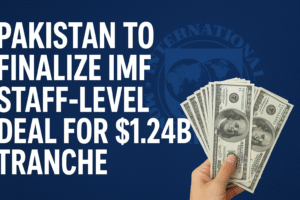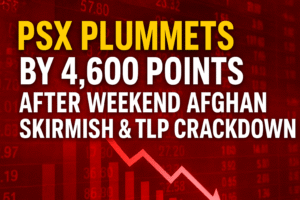Global Equity Funds Hit 11-Month High Inflows | Fed Rate Cut Hopes Boost Markets
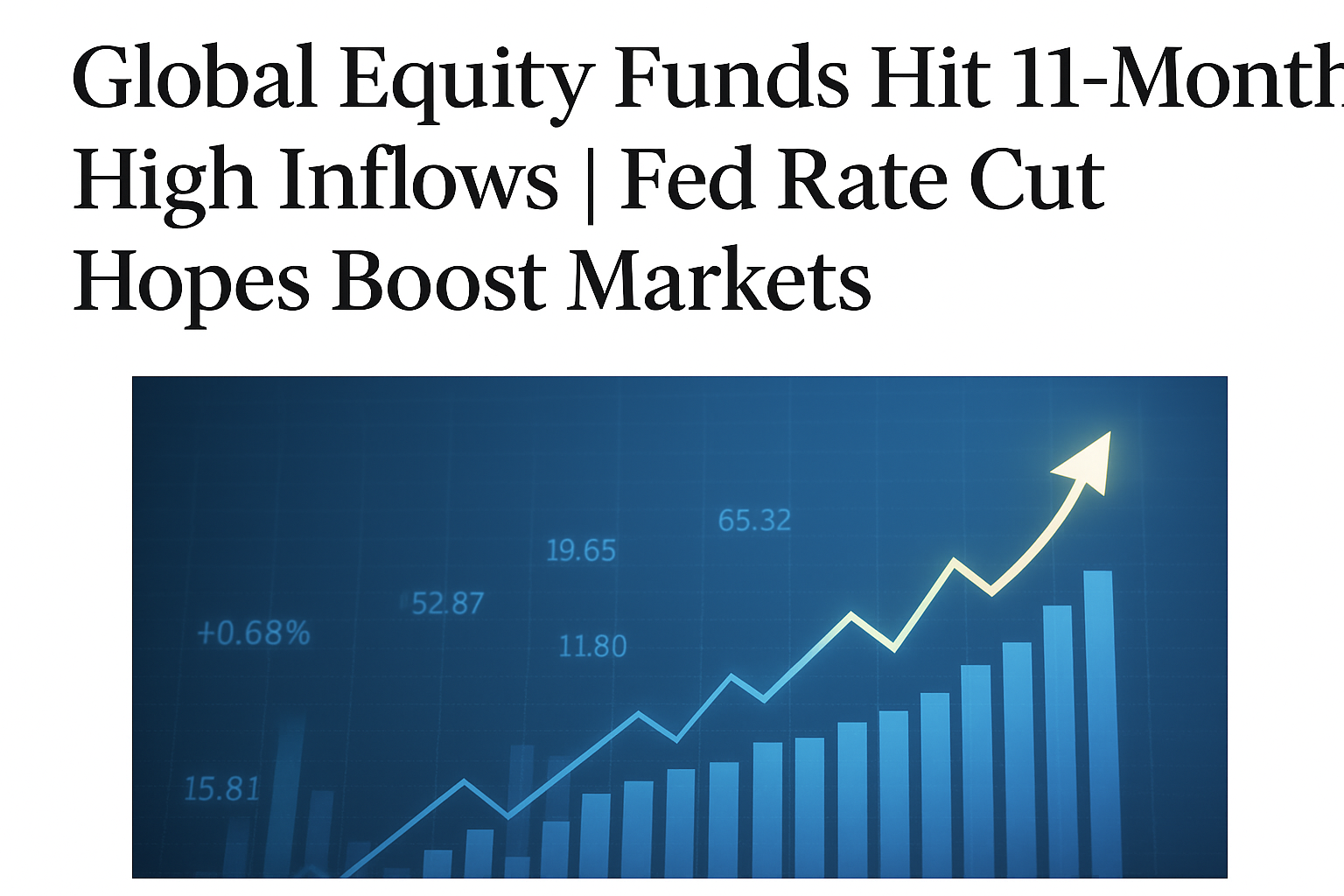
Introduction
Global markets have entered a decisive phase, with investors shifting their strategies based on the latest signals from the U.S. Federal Reserve. In the first week of October 2025, global equity funds witnessed a massive surge in inflows — their highest in nearly 11 months.
This sharp rise underscores how rapidly investor sentiment can pivot in anticipation of a policy shift. The optimism largely stems from growing confidence that the Federal Reserve will soon begin cutting interest rates amid softening inflation and weaker job data. Global Equity Funds Hit global equity fund inflows, Fed rate cut hopes, market optimism 2025, U.S. equities inflows, global investor trends Global Equity Funds Hit global equity fund inflows, Fed rate cut hopes, market optimism 2025, U.S. equities inflows, global investor trends.
The sudden injection of capital into equities has not only lifted U.S. markets but also revived investor interest across Europe, Asia, and emerging economies. This development has reignited discussions around global liquidity, asset allocation, and whether this bullish wave marks the start of a longer-term rally or the peak of market euphoria.
This detailed report examines:
-
The precise data behind the inflows
-
The driving factors behind investor optimism
-
Regional and sector-wise flow trends
-
Risks and market vulnerabilities
-
Strategic takeaways for investors and analysts
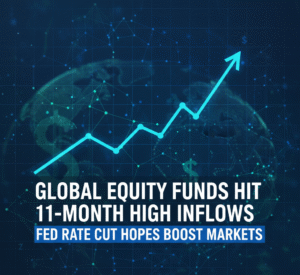
1. Data Snapshot: Record Equity Inflows in 11 Months
During the week ending October 1, 2025, global equity funds attracted $49.19 billion, marking their strongest week since late 2024.
Breakdown by region:
-
U.S. Equity Funds: $36.41 billion in net inflows — the highest among all markets.
-
European Funds: $7.36 billion.
-
Asian Funds: $3.94 billion.
-
Global Sector Funds: $11.56 billion combined, led by technology and financials.
Other key categories also showed interesting patterns:
-
Bond Funds: $6.06 billion in inflows — their 24th consecutive positive week, though at a slower pace.
-
Money Market Funds: $8.84 billion added — a rebound after three weeks of outflows.
-
Precious Metals Funds: $4.66 billion, marking their sixth straight week of net buying.
-
Emerging Market Equities: A small outflow of $239 million, while emerging market bond funds added $373 million.
These figures clearly demonstrate that investors are returning to risk assets, albeit selectively and strategically.
2. Key Drivers Behind the Surge in Equity Flows
A. Federal Reserve Rate Cut Expectations
The single biggest catalyst behind the surge is the expectation of imminent U.S. rate cuts. Investors are betting that the Federal Reserve will move toward monetary easing sooner than previously forecast.
-
Softening inflation: Inflation indicators have begun to moderate, suggesting that price pressures may finally be stabilizing.
-
Weak employment data: Slower job growth and a mild uptick in unemployment have encouraged bets that the Fed’s tightening cycle is ending.
-
Revised forecasts: Leading investment banks have moved up their projections for rate cuts — some from December to October 2025.
-
Market sentiment: Futures markets are now heavily pricing in one or two rate cuts before the year ends.
Lower interest rates typically make equities more appealing compared to bonds and cash, explaining why large sums have been redirected into stock markets.
B. Search for Yield and Growth
After years of volatile fixed-income returns, investors are chasing better yields through equities. Lower rates reduce the attractiveness of bonds, leading to an equity rotation, particularly into growth-oriented and dividend-paying sectors.
C. Sector Confidence: Tech and Financials Dominate
-
Technology funds received over $4 billion in new money, reflecting investor enthusiasm for artificial intelligence, cloud computing, and chip innovation.
-
Financials attracted around $3 billion as lower borrowing costs are expected to boost loan activity and profitability.
Other sectors such as industrial, healthcare, and consumer discretionary also drew fresh capital, showing broader confidence in the economic outlook.
D. Global Diversification Strategy
Institutional investors have increasingly shifted capital toward Asia and Europe to balance over-exposure to U.S. assets. Analysts note that Asia (excluding China) has attracted close to $100 billion in new investments in recent months, signaling a deliberate diversification trend.
3. Regional Breakdown and Market Implications
3.1 United States
U.S. equities remain the core driver of global flows. The country’s robust market infrastructure, liquidity, and tech leadership have made it the first stop for global capital.
-
Large-cap dominance: Most of the inflows were directed into large-cap funds, particularly in the S&P 500 and Nasdaq-focused ETFs.
-
Tech momentum: Major firms in AI, semiconductors, and digital services continue to attract heavy investor interest.
-
Investor psychology: Many believe a rate cut could trigger another leg of growth, supporting corporate earnings and valuation stability.
However, risks persist — stretched valuations, excessive optimism, and potential profit-taking could lead to volatility.
3.2 Europe
Europe has emerged as a quiet winner of this global rally. With equity funds gaining over $7 billion in a week, investors are rediscovering value in a region known for underperformance and discount valuations.
Key factors:
-
Anticipation of European Central Bank (ECB) rate cuts in tandem with the Fed.
-
Rising demand for cyclical sectors like manufacturing and finance.
-
Attractive price-to-earnings ratios compared with U.S. counterparts.
Challenges include sluggish growth, energy dependence, and political uncertainty — especially in France, Germany, and Italy.
3.3 Asia and Emerging Markets
Asian markets witnessed over $3.9 billion in inflows, signaling investor appetite for growth diversification.
-
Asia ex-China is receiving the largest portion of new money, especially India, South Korea, and Indonesia.
-
China’s case is mixed: Foreign inflows remain weak amid policy concerns and property sector stress. Domestic investors continue to drive local rallies.
-
Emerging Markets: Outflows from equities and modest inflows to EM bonds indicate selective risk-taking — investors prefer debt exposure over equities in higher-risk countries.
Overall, Asia’s demographic growth, digital economy expansion, and lower valuations remain compelling long-term drivers.
4. Sector Analysis: Where the Money Is Going
Technology: Still the Top Magnet
The tech sector remains investors’ favorite, backed by enthusiasm for AI, automation, and digital transformation. Lower interest rates could make it easier for tech firms to finance innovation, leading to stronger valuations.
Financials: Renewed Confidence
Banks and insurance companies stand to benefit from cheaper capital and increased lending demand once rate cuts take effect. This sector also appeals to value investors looking for stable dividends.
Industrials and Consumer Discretionary
As optimism grows about a global “soft landing,” manufacturing and consumer spending are expected to recover, driving gains in these sectors.
Healthcare and Energy
Healthcare stocks have seen moderate inflows due to stable demand, while energy remains volatile but supported by ongoing OPEC+ supply management and geopolitical tensions.
5. The Broader Economic Context
A. Inflation and Growth Balance
Recent data suggest that inflation is gradually cooling without a dramatic collapse in growth — an ideal combination known as a “soft landing.” This balance supports continued risk-taking in equities.
B. Central Bank Coordination
Markets expect synchronized easing from the U.S. Federal Reserve, the European Central Bank, and possibly the Bank of England in early 2026. This coordination boosts liquidity globally.
C. Currency Dynamics
The U.S. dollar has started to weaken slightly, enhancing the relative attractiveness of non-U.S. assets. For emerging markets, a weaker dollar also eases debt servicing pressures.
6. Investor Behavior and Sentiment Shifts
Institutional vs. Retail Participation
Institutional investors, such as pension and sovereign wealth funds, have been leading the inflow wave. However, retail participation is rising through ETFs and mutual funds, reflecting renewed confidence among small investors.
Sentiment Indicators
-
Investor confidence indexes are at 10-month highs.
-
Volatility indexes (VIX) are at their lowest since early 2024.
-
Equity allocation ratios in global portfolios are climbing steadily, signaling a pro-risk stance.
Caution Signs
Such bullish sentiment can create “crowded trades.” When everyone rushes to buy, markets become vulnerable to sudden corrections if expectations shift.
7. Risk Factors to Watch
1. Inflation Surprises
If inflation rebounds unexpectedly, it could derail rate-cut hopes and send yields higher — pulling money back out of equities.
2. Policy Communication Risks
Mixed messaging from the Federal Reserve could trigger market confusion and volatility.
3. Overvaluation
U.S. large-caps, especially in tech, are trading near record valuations. A disappointing earnings season could prompt a re-rating.
4. Geopolitical Risks
Ongoing conflicts, trade disputes, or political instability in Europe or Asia could easily unsettle capital flows.
5. Liquidity Reversal
If central banks reduce liquidity injections faster than expected, equity flows could reverse abruptly.
8. Outlook for the Rest of 2025 and Beyond
Short-Term (Q4 2025)
-
Investors will watch key U.S. inflation and jobs reports closely.
-
The Fed’s October and December meetings could determine whether the rate-cut narrative continues.
-
Expect continued inflows unless macro data sharply disappoint.
Medium-Term (2026)
-
If rate cuts materialize, corporate profits could expand further, supporting equities.
-
Sectors like AI, green energy, and finance are expected to outperform.
-
However, potential global slowdown risks remain if central banks overshoot in cutting rates too fast.
Long-Term
Structural growth themes — such as digital infrastructure, aging populations, and decarbonization — will drive equity allocations globally.
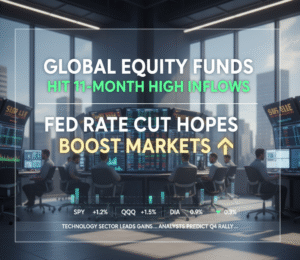
9. Strategic Takeaways
-
Equities Are Back in Focus: The return of large inflows shows renewed confidence in growth assets.
-
U.S. Remains Core, but Diversification Is Rising: Europe and Asia are seeing sustained interest.
-
Sector Selectivity Matters: Tech and finance lead; cyclicals are next.
-
Risks Are Real: Inflation shocks, policy missteps, or geopolitical crises could reverse flows.
-
Long-Term Investors Should Stay Disciplined: Maintain diversification, manage risk, and watch valuation levels.
10. Expert Commentary Summary
Financial strategists emphasize that while inflows are strong, the rally is data-dependent. If inflation cools steadily, the equity momentum could last into 2026. But if inflation re-emerges, the market could quickly shift back to defensive positioning.
The consensus is cautiously optimistic: the next few months could mark the beginning of a new liquidity-driven expansion phase — but only if the Federal Reserve executes its policy pivot smoothly.
11. Conclusion
The 11-month high in global equity fund inflows marks a crucial turning point in investor psychology. After nearly two years of volatility and uncertainty, the market appears to be regaining faith in equities.
Fed policy expectations are driving optimism, but that optimism comes with responsibility — investors and policymakers alike must remain vigilant against complacency. Global Equity Funds Hit global equity fund inflows, Fed rate cut hopes, market optimism 2025, U.S. equities inflows, global investor trends Global Equity Funds Hit global equity fund inflows, Fed rate cut hopes, market optimism 2025, U.S. equities inflows, global investor trends


